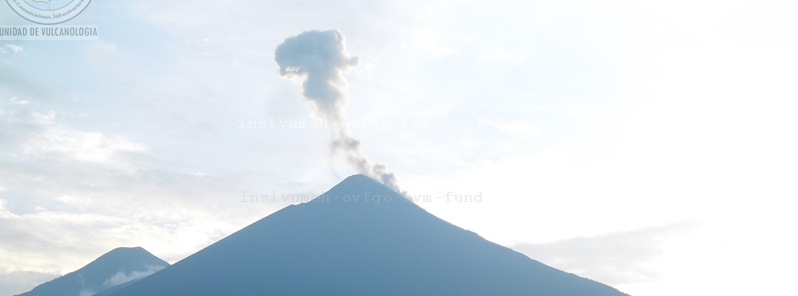Increased activity at Fuego volcano, Guatemala

Volcanic activity at Guatemalan Fuego remains high and has increased in the past few days. Frequent weak, moderate, and some strong strombolian explosions are reported, as well as ashfall in nearby villages. Ash plumes are reaching an average height of 4.5 km a.s.l., about 800 – 1000 m above the crater.
Incandescent tephra can be observed reaching about 150 m above the crater and block avalanches are descending multiple drainages.
INSIVUMEH said 18 small to moderate explosions occurred on May 22 with ash plume rising up to 4.7 km a.s.l. Slight vibrations were felt in homes within 8 km from the crater. Ashfall was reported 10 – 12 km W and SW from the volcano, in Panimaché I and II, Morelia, Hagia Sophia, El Porvenir and nearby villages.
This activity is also accompanied by sounds similar to locomotive train, with degassing periods of 1 to 3 minutes.
Volcán de Fuego ha registrado 18 explosiones entre débiles y moderadas con columnas de 4,700 msnm. pic.twitter.com/cW1igMSzKz
— CONRED (@ConredGuatemala) May 22, 2015
In a special report from May 18, INSIVUMEH stated that hours after of an effusive eruption that ended at 17:30 (local time) observers noted ash plumes drifting 10 km and a S-flank lava flow. The report also stated that inclement weather had hindered views during the previous few days.
During May 18 – 19 explosions generated ash plumes that rose 550 – 750 m and drifted 10 km W and SW. Ash fell in Morelia, Panimache I and II, and Santa Sofía.
Geologic summary
Volcán Fuego, one of Central America's most active volcanoes, is one of three large stratovolcanoes overlooking Guatemala's former capital, Antigua. The scarp of an older edifice, Meseta, lies between 3763-m-high Fuego and its twin volcano to the north, Acatenango.
Construction of Meseta dates back to about 230,000 years and continued until the late Pleistocene or early Holocene. Collapse of Meseta may have produced the massive Escuintla debris-avalanche deposit, which extends about 50 km onto the Pacific coastal plain. Growth of the modern Fuego volcano followed, continuing the southward migration of volcanism that began at Acatenango.
In contrast to the mostly andesitic Acatenango, eruptions at Fuego have become more mafic with time, and most historical activity has produced basaltic rocks. Frequent vigorous historical eruptions have been recorded since the onset of the Spanish era in 1524, and have produced major ashfalls, along with occasional pyroclastic flows and lava flows.
Featured image: Fuego erupting on May 22, 2015. Credit: INSIVUMEH.

Commenting rules and guidelines
We value the thoughts and opinions of our readers and welcome healthy discussions on our website. In order to maintain a respectful and positive community, we ask that all commenters follow these rules:
We reserve the right to remove any comments that violate these rules. By commenting on our website, you agree to abide by these guidelines. Thank you for helping to create a positive and welcoming environment for all.